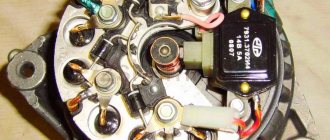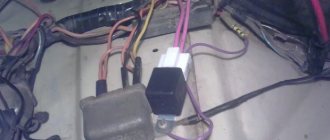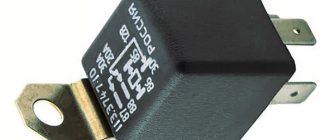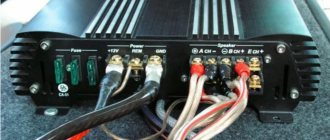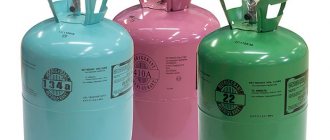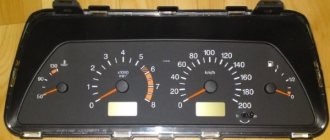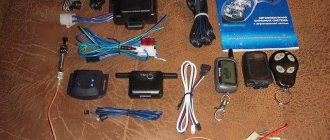Connection diagrams
A pulse relay can be used to control lights. To ensure the operability of electrical systems with installed switching elements of this type, it is necessary to correctly perform the work of connecting the conductors.
First of all, it should be borne in mind that a pulse-type relay is not equipped with any protection elements, therefore, if a short circuit occurs in the electrical wiring of lighting devices, not only the relay contacts may burn out, but also the ignition of any flammable objects located in the immediate vicinity of copper conductor. To minimize possible consequences, the installation of pulse relays should be carried out only after the machine (or fuses (plugs)).
Push-button switches are used to switch relay modes. Such elements of electrical fittings are equipped with spring elements that return the button to its original position immediately after the mechanical pressure on its surface ceases. This is a very important point, because if the contact is closed for too long, the coil winding may overheat and the product (electromechanical) will fail.
Many manufacturers of impulse switches indicate in the product documentation that it is impossible to supply electric current to the coil for a long time (usually no more than 1 s).
The number of switches with which a signal is supplied to the pulse relay is not limited in any way, but, in many cases, there are 3-4 buttons in the device connection diagram. This is enough to control the light from several places.
All push-button switches are connected in parallel to each other. This feature of controlling a pulse device allows you to use a significantly smaller number of wires, compared to other methods of installing a control system for one light device from different places. One wire of the contact system of switches is connected to the electrical wiring phase, the other is connected to the pulse relay (contact A1).
In addition to supplying the phase wire from the switches, the phase is connected to contact “2” of the pulse device. This ensures the transmission of a signal to turn it on (off), as well as providing the device with electric current to supply voltage to consumers (lighting devices).
“Zero” is connected to contact “2”. Lighting devices are connected to the “ground” not through a switching device. The neutral wire is connected to the lighting fixture from the neutral bus.
Physical placement of the pulse relay is possible both in electrical panels and in the immediate vicinity of the lighting device (installation is carried out in a junction box).
Advantages of functional lighting equipment
Fog lights allow you to partially relieve the strain on the driver's eyes during a forced trip in difficult weather conditions. With their help, it is possible to achieve better illumination of the road surface. The greatest importance of headlights lies in the precise supply of light, which determines the illumination of the road.
Precisely adjusted devices illuminate up to 10 meters of space in front of the car, which is quite enough for safe driving in difficult weather conditions. Of course, for this you will need to adhere to a certain speed limit. The headlights are adjusted during the installation of the equipment. The quality of road lighting depends entirely on the setting of the angle of incidence of the light flux.
We recommend: Reading the battery like an open book: rules for deciphering battery markings
What are timers, pause relays, delays
Let’s make a reservation right away: homemade auto-timers adjust the delay from a few seconds to 10–15 minutes. There are schemes only for incl. and for on/off load, as well as for activation at certain times of the day. But their delay range and options are limited; there is no function of periodically operating independently several times and adjusting the intervals between such cycles, like in factory outlet devices. However, the homemade capabilities (there are also ready-made similar simple modules on sale) are enough to activate garage ventilation, lighting in the pantry and similar not too demanding operations.
A temporary relay (timer, pause, delay relay) is an automatic release that is triggered at the moment set by the user, turning on/off (closing/opening contacts) of an electrical appliance. The timer is extremely practical in situations where the user needs the device to be activated or deactivated while he is in another location. Also, such a unit will help out in ordinary everyday situations, for example, it will protect you when you forget to turn off/on the equipment.
Thus, the temporary relay will eliminate situations where you left an electrical appliance on, forgot to turn it off, and, accordingly, it burned out or, even worse, caused a fire. By turning on the timer, you can go about your business without worrying about having to return at a certain time to service the equipment. The system is automated, the unit itself will turn off when the set period on the release has expired.
Where is it used?
Many people are familiar with the clicking sounds in Soviet washing machines, when large graduated selectors set a certain delay before turning on/off. This is a vivid example of this device: for example, they set it to work for 10–15 minutes, the drum spun for this time, then, when the clock inside reached zero, the washing machine turned itself off.
Manufacturers always install temporary relays in microwave ovens, electric ovens, electric water heaters, and automatic watering systems. At the same time, many devices do not have it, for example, lighting, ventilation (hood), then you can buy an additional timer. In its simplest form, it looks like a small rectangular block with time selectors and a plug for a regular socket (“daily” timer sockets) into which it is inserted. Then the power cable plug of the device being serviced is inserted into it, and the delay time is adjusted using the controls on the body. There are also standard sizes for placement by connecting to a line (with wires, wiring, for switchboards), for integration inside devices.
Device, types, features
Mostly timers in factory electrical appliances with trip units are based on a microcontroller, which often also controls all operating modes of the automated device where they are installed. The described combination of functions is cheaper for the manufacturer, since there is no need to manufacture separate microcircuits.
We will describe the simplest time delay relay circuits, only with an on/off option. and selecting a time pause in a small range (up to 15–20 minutes):
- for low-voltage power supply (5–14 V) - on transistors;
- on diodes - for power supply directly from a 220 Volt network;
- on microcircuits (NE555, TL431).
There are special factory modules, they can be bought on online sites (Aliexpress, similar and specialized resources), on radio markets, in special stores. Completely handicraft products are created according to similar schemes, mainly for simple tasks: elementary disengagement/coupling of contacts at a certain, specified point in time, while the delay range is small from seconds to 15–20 minutes.
Types and characteristics of pulse relays
Pulse relays can have a modular design for installation on a DIN rail in a panel, but devices of various sizes and shapes with a different mounting method are also available. Modular devices produced by different manufacturers may also differ in appearance. For example, pulse relays from ABB and Schneider Electric have operation indicators and a manual mechanism control lever.
It will be interesting Description and principle of operation of solenoids
The designation of the connection terminals may also vary. As development progresses, products of the same brand also change. For example, a relay of the previously popular E251 series from ABB, no longer in production, looks like this, and its analogue E290 now has a slightly different look. Series from the same manufacturer also differ in internal circuitry. The main characteristics of pulse relays are:
- Number and initial condition of contacts;
- Rated control voltage;
- Coil actuation current;
- Rated current of the power circuit;
- Control pulse duration;
- Number of connected switches;
The last indicated characteristic depends on the presence of backlight lamps in the switches, the total current of which can lead to the operation of the coil. If the pulse relay is electronic, then it is susceptible to radio interference and interference from surrounding power circuits. Since there is a wide variety of bistable relays, without reference to a specific manufacturer, we can only consider a generalized connection diagram.
Relay operation circuit
A common feature of these relays is that they do not have built-in overload protection and must be protected by circuit breakers.
Since a small current is required to operate the coil, compared to the switched load, the control circuits can be carried out using cables with a core cross-section of 0.5 mm², but in this case, a separate circuit breaker must be installed for this electrical wiring to prevent the wires from catching fire when they are short circuit.
As a rule, manufacturers indicate the time during which the coil can be energized. For example, with ABB it is not limited, but with less famous brands, pulse relays can heat up when there is electric current in the coil circuit for a long time, therefore, when buying a pulse relay, it is necessary to clarify this parameter, because there may be cases when accidentally moved furniture will cause constant pressing the switch button.
If you look at the ABB catalog, you can see that there are pulse relays (old series - E256, new analogue E290-16-11/), which have one normally open and one closed contact, actually operating in switch mode. Such devices can be used to control lighting systems in production, to switch between main and emergency lighting. Thanks to this function, the production room will never be in the dark due to the fault of personnel who forgot to turn on the emergency light - switching is carried out with one press of the switch key.
Pulse relay with digital control
It is also possible to control the lighting both locally (one pulse relay is controlled using several parallel connected buttons) and centrally (simultaneously for several identical devices) using two keys - on and off. For example, E257 series relay wiring diagram. Here, by pressing the central buttons (ON, OFF), all relays are controlled, plus each has its own local control. The updated ABB line uses the principle of combining modules to create multi-level control systems.
The use of different control voltages also expands the functionality of lighting control devices. For example, the impulse relay of the E251-24 series (its updated analogue E290-16-10/24) is controlled by a constant voltage of 12V (or alternating 24V), which makes the operation of switches located in humid environments where there is a risk of electric shock safe.
It will be interesting What is a thermal relay
Such a device can be successfully used to control lighting in a bathhouse or sauna, where the use of devices operating with mains voltage is not allowed. In addition, the low-voltage control signal can be generated by various computerized devices, which allows automation of lighting control processes.
What are fog lights for?
The vehicle's standard headlights provide sufficient visibility in clear weather. However, in bad weather it is of little use. The problem is that the rays of the low and high beam lamps are reflected from drops of fog or snowflakes, creating a “white veil” in front of the car.
This is a consequence of two factors:
- narrow optical beam is better reflected from the surface;
- Highly mounted headlights highlight areas with a high concentration of fog droplets.
PTFs are specially designed for operation in severe weather conditions. And this is not about yellow filters, which some drivers consider a panacea in foggy weather. It’s not for nothing that traffic regulations allow the installation of PTF in two colors - white and yellow.
These headlights cope with bad weather thanks to a couple of important properties:
- Width of the light beam . A wide beam is less reflected from water and ice and does not create a “white veil”.
- Mounting height . The concentration of fog near the ground is lower. Therefore, the low location allows illumination under the veil.
The last point is especially important. If you install the PTF at the level of the headlights, they will not cope with their task.
In addition to the front PTFs, which improve visibility from the driver's seat, rear fog lights are used, duplicating the dimensions. They clearly identify the car in poor visibility conditions, but are excessively bright. Therefore, they should not be turned on in clear weather.
Electrical connection diagram
Depending on the needs of the user and his financial capabilities, you can choose one of the methods of connecting the deep pump to the electrical network.
Without automation
Without auxiliary control devices, the pump is connected using a pre-installed electrical outlet with a grounding contact. The pump is also grounded. For this purpose, the main bus of the house is used, connecting to the existing ground loop of the building.
A three-core cable is used to supply electricity to the outlet. The power supply voltage of the submersible pump is 220V. 380-volt or 150-volt outlets cannot be used.
Via pressure switch
To reduce the cost of a set of pressure equipment, you can use a connection diagram for a well pump only with a pressure switch without a control unit. The device turns off the pump when the pressure reaches a maximum, and starts it when the pressure drops to a minimum.
Using control unit
When selecting an automation model, you first need to find out what protective system is already installed in the pump by the manufacturer. Modern devices are already protected from overheating and idle operation. Sometimes the equipment is equipped with a float mechanism. Taking this data into account, you can choose one of three automation options - simple, with a second or third generation electric control unit.
The simplest protection is most often used for automatic water supply. The control unit here is assembled from three devices:
- Dry running blocker. It will turn off the device, which operates without water, preventing overheating. Sometimes the additional installation of a float switch is allowed. It performs the same functions, turning off the pumping equipment when the water level drops, preventing it from overheating. The devices may seem primitive, but they provide effective protection for the electric motor.
- Hydraulic accumulator. Without it, it will not be possible to provide automatic water supply. The hydraulic tank works as a water storage tank. Inside there is a working mechanism - a diaphragm.
- Pressure switch equipped with a pressure gauge. This device allows you to configure the operation of relay contacts.
It is not difficult to equip pressure equipment with simple automation with your own hands. The principle of operation of the system is simple: as water flows, the pressure in the hydraulic tank decreases. When the minimum value is reached, the relay starts the pressure equipment, which pumps water into the storage tank. When the pressure in the hydraulic accumulator reaches its maximum, the relay device turns off the installation. As water is consumed, the cycle repeats.
The pressure limits in the storage tank are adjusted using a relay. In the device, using a pressure gauge, the minimum and maximum response parameters are set.
In second-generation automation, the connection is made through an electrical unit with a set of sensors. They are mounted directly on pressure equipment, as well as inside the water supply network, and allow the system to function without a hydraulic tank. The impulse from the sensors goes to the electronic unit, which controls the system.
Operation of pressure equipment with this scheme for connecting a submersible well pump to automation:
- Liquid accumulates only in the water supply where one of the sensors is installed.
- When the pressure drops, the sensor sends a pulse to the control unit, which starts the pump.
- After reaching the required pressure of the water flow in the water supply, the pump is turned off according to a similar scheme.
To install such automation, you will need basic knowledge of electrical engineering. This and the previous protection work almost identically - based on water pressure. However, the electric unit with sensors is more expensive, which is why it is not so popular among consumers. Even when using automation, you don’t have to use a hydraulic tank, although if there is a power outage, you won’t be left without water. There is always a reserve left in the drive.
Third generation automation is reliable, high quality and expensive. Its installation allows you to significantly save on electricity due to ultra-precise tuning of the electric motor. The connection diagram for advanced automation to a deep well pump is very complex, so you should contact a professional to connect it. But it provides complete protection of the motor from various breakdowns, for example, overheating during dry running or burning of the windings during power surges.
The unit operates from sensors without a hydraulic tank. Efficiency is achieved through fine adjustments.
Electromagnetic starter
An electromagnetic starter is an electrical device that allows you to start, stop and protect three-phase asynchronous electric motors.
In addition, these devices allow you to start and turn off any type of load, for example, heating elements, lighting sources and others.
Electromagnetic starters are produced in single or dual versions. The latter have mechanical protection against simultaneous starting.
Open-type devices are used in panel installations; they are used inside closed specialized cabinets, as well as in other places that are reliably protected from small particles and mechanical damage.
In contrast, protected starters can be used indoors if the environment is not very dusty. There are also starters that have reliable protection from moisture and dust; they can be used in both indoor and outdoor installations.
Installation features
In order for the starter and time relay to operate reliably, they must be installed correctly. Devices must be firmly fixed.
Do not install devices in places that may be subject to shock and vibration, for example, where electromagnetic devices (more than 150 A) are installed that create shock and vibration when turned on.
If one conductor is connected to the contacts of the magnetic starter, it must be bent in a U-shape to prevent distortion of the clamp spring washer.
If two conductors are connected, they must be straight and each must be located on the same side of the clamp screw. It is imperative to check that the conductors are securely fastened.
Before connecting to the starter, the ends of the copper conductors must be tinned and the stranded ones twisted. However, do not lubricate the contacts and moving parts of the starter.
Diagram of parallel connection of fog lights
The electrical circuits for installing fog lights differ only in the number of positive wires stretched to the lamp bases. The sequential circuit involves laying one cable from pin “87” to the left headlight. At the place where the terminal is attached, a second wire is connected to it, which stretches to the base of the right lamp.
Parallel activation of the PTF involves laying a pair of separate cables from the relay to each fog lamp.
In addition to the two wires to the PTF lamps, you can run a third one, going to the “control”, which signals the activation of the fog lights. It is installed on the instrument panel. There is a place for it on all modern cars. The only thing you need to connect is to buy a base and a lamp (incandescent or LED) of the appropriate size.
Power cords should be routed so that they do not pass near hot or sharp parts of the machine. In places where the wire may be bent or the insulation may be damaged, they should be protected with corrugation or an additional layer of electrical tape.
After installation and connection of the PTF, it is necessary to adjust the position of the beams. Headlights should not shine upward. Otherwise, they will dazzle oncoming drivers, but will not help you see the road in the fog. You should also make sure that the beam clearly illuminates the side of the road. This will help you pass inspection without any problems and ensure good visibility even in fog or snow.
Connecting the water pressure switch
The water pressure switch for the pump is connected to two systems at once: electricity and water supply. It is installed permanently, since there is no need to move the device.
Electrical part
To connect a pressure switch, a dedicated line is not required, but is desirable - there is a greater chance that the device will work longer. A cable with a solid copper core with a cross-section of at least 2.5 square meters must run from the shield. mm. It is advisable to install a combination of automatic + RCD or difavtomat. The parameters are selected based on current and depend more on the characteristics of the pump, since the water pressure switch consumes very little current. The circuit must have grounding - the combination of water and electricity creates a zone of increased danger.
Connection diagram of the water pressure switch to the electrical panel
The cables are inserted into special inputs on the back of the case. Under the cover there is a terminal block. It has three pairs of contacts:
- grounding - the corresponding conductors coming from the panel and from the pump are connected;
- line or “line” terminals - for connecting the phase and neutral wires from the panel;
- terminals for similar wires from the pump (usually on the block located above).
Location of terminals on the water pressure switch housing
The connection is standard - the conductors are stripped of insulation, inserted into the connector, and tightened with a clamping bolt. By pulling the conductor, check whether it is securely clamped. After 30-60 minutes, the bolts can be tightened, since copper is a soft material and the contact may weaken.
Pipeline connection
There are different ways to connect a water pressure switch to the plumbing system. The most convenient option is to install a special adapter with all the required outputs - a five-pin fitting. The same system can be assembled from other fittings, it’s just that it’s always easier to use a ready-made version.
It is screwed onto the pipe on the back of the housing; a hydraulic accumulator, a supply hose from the pump and a line that goes into the house are connected to the other outputs. You can also install a mud pan and a pressure gauge.
An example of tying a pressure switch for a pump
A pressure gauge is a necessary thing - to monitor the pressure in the system, monitor the relay settings. A mud trap is also a necessary device, but it can be installed separately on the pipeline from the pump. In general, a whole system of filters for water purification is desirable.
With this scheme, at high flow rates, water is supplied directly to the system - bypassing the hydraulic accumulator. It begins to fill after all the taps in the house are closed.
Requirements for installing fog lights
PTFs consist of three housings with a base for mounting the lamp, a reflector and a glass diffuser, which provide the desired shape of the light beam. The operating features and purpose of fog lights imposes special requirements on them, which are reflected in the current traffic rules:
- You can install no more than 2 headlights;
- PTFs must be mounted at a distance of 40 cm from the side edges of the car and above 25 cm from the road surface;
- the beam should be directed lower than the low beam headlights;
- viewing angles cannot go beyond the following values: -10...+15 degrees and -10..+45 vertically and horizontally, respectively.
The bumper of modern cars has special places for installing fog lights. If they are not available, fog lights should be mounted according to the manufacturer's recommendations. Main requirements:
- rigid mounting of PTF on brackets;
- fuse protection of power supply;
- correct angles of direction of light beams.
